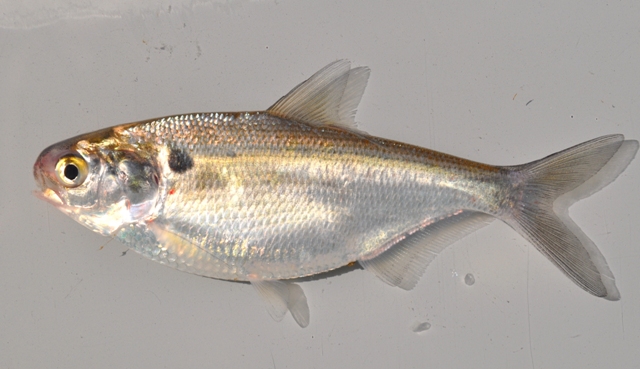Gizzard Shad
(Dorsoma cepadianum)

Gizzard shad are often the most abundant food source for many sport fish in Ohio's reservoirs. Because of this, they make excellent bait especially for catfish.
Description
Gizzard shad are a deep bodied fish that is laterally compressed (nearly flat when lying on their side). They have a bright silver body with slate gray fins. There is a dark spot just behind the gill openings on the upper sides. They have a small sub-terminal (ending below tip of snout) mouth that does not extend much beyond the front edge of the eye. The dorsal fin is positioned directly above the pelvic fins and they, like other Dorosoma sp., have a greatly extended last dorsal ray that extends about as far back as the center of the anal fin. Their belly comes to a point with a single row of scales folded over the edge. This gives their belly a sharp saw like edge. Gizzard shad differ from the closely related threadfin shad by having a shorter extension of the last dorsal ray, no yellow coloration in the tail and fins, and a sub-terminal mouth. Both species are very frail fish and when handled their scales often come off on your hands.
Habitat and Habits
Gizzard shad are found throughout Ohio in both the Lake Erie and Ohio River drainage. They are most common in large rivers and reservoirs. They are often the most abundant fish in reservoirs where large schools of them can be seen swimming near the surface.
Reproduction and Care of the Young
Gizzard shad usually spawn in May by broadcasting as many as 500,000 eggs over submerged objects such as rocks or logs near the shore. Each year, after spawning, they can become extremely abundant providing food for many larger fish species. They are sensitive to cold winter temperatures and large numbers are often found dead when the ice melts off of reservoirs. The relatively low number of survivors can quickly repopulate the reservoir starting the whole cycle over again.